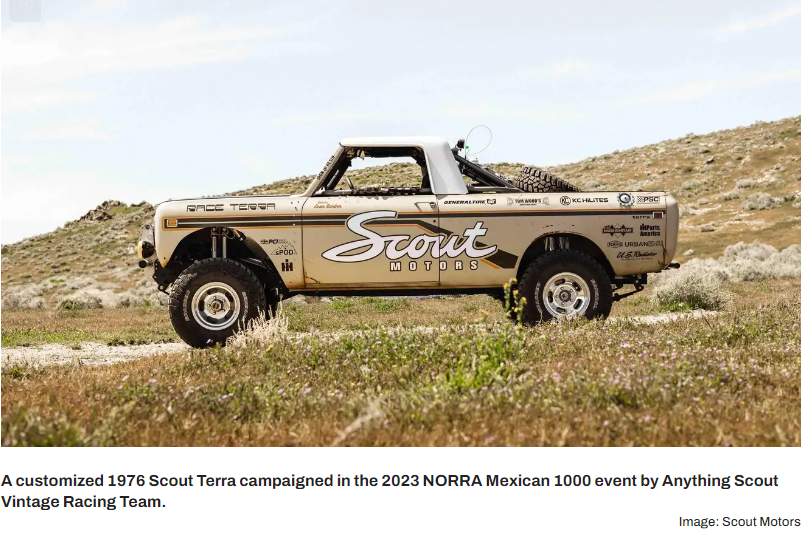Volkswagen’s Scout Wants To Be As American As Apple Pie
Volkswagen may be a big company, but as far as its business in America is concerned, it hasn’t taken many big swings in recent years. There was that attempt to compete with Toyota on a volume level with a cut-rate Jetta and Passat for a hot minute, which was promptly undone by Dieselgate. Since then, the brand has kept things under the radar. But a new strategy has emerged — one that The Wall Street Journal summed up perfectly in the first paragraph of a story published this past holiday weekend: “After decades of trying to sell German engineering to Americans only to end up with a tiny slice of the world’s most profitable car market, Volkswagen has a new strategy: Pretend it is American.”
The article goes into Volkswagen of America’s efforts to build Scout by itself, with a surprising degree of autonomy allowed from HQ in Wolfsburg. VW’s chief executive shakeup last year temporarily left the project in doubt, and garnering the new boss’ support wasn’t guaranteed:
Scout was one of the main projects launched under VW CEO Herbert Diess. So when Diess was ousted and replaced by Oliver Blume, the chief of VW’s sports-car brand Porsche, last September, Keogh’s plan was thrown into question.
Blume has said he wants to strengthen VW’s U.S. business, and as VW board member he had been part of the discussions about Scout. But as the new CEO, he had already begun to scrap some of his predecessor’s projects.
Last November, Keogh said, he and his team met Blume in an old warehouse on the sidelines of the LA Auto Show. Keogh showed Blume the promotional video, called “America’s Next Shot,” created by San Francisco ad agency Venables Bell & Partners.
It opens with images of wheat fields, a cowboy riding a horse on the plains, steelmaking, American flags and archival footage of Scout vehicles scrambling up hills and dirt roads. The narrator talks about the revival of American manufacturing and the Scout, saying: “It is America’s next shot. And we do not intend to miss.”
“We spent four to five hours with him in Los Angeles at the motor show and gave him a deep dive on everything as to where we are. And…he has been a powerful supporter,” Keogh said.
Former Volkswagen of America chief-turned-Scout CEO Scott Keogh appears to have found the right recipe for currying local favor as well:
Having picked a site near Columbia, S.C., Keogh and several top VW executives in February attended a working dinner hosted by South Carolina Gov. Henry McMaster at his Civil War-era mansion with a commanding view of the Broad and Saluda rivers.
Guests included South Carolina Sen. Lindsey Graham, the state’s Commerce Secretary Harry Lightsey and Richland County officials. The governor’s English bulldog Mac wove his way through the crowd, settling next to Keogh, according to participants.
Keogh showed his video and made a 15-minute pitch describing Scout as the embodiment of the American dream, McMaster recalled in a recent interview.
“It was a combination of rugged individualism, can-do spirit, American patriotism and an excellent vehicle,” the governor recalled. “Those things can climb walls. It particularly appeals to South Carolinians.”
A month later, South Carolina lawmakers approved $1.3 billion to help VW build the plant.
Scout Motors hires key Jeep, Ram designer to lead EV rollout
The re-emergence of Scout Motors in the electric era became significantly more interesting. when last week, Scout revealed it hired Chris Benjamin, a key Stellantis designer who crafted the interior style of some of the latest Jeep and Ram models, to lead the design of its rugged, all-purpose electric truck and SUV.
Benjamin will join the brand as Chief Design Officer, or “the steward of the iconic Scout design,” according to the company.
He will oversee the interior and exterior design, concept development, user experience, and the integration of design and tech into the Scout Motors brand.
“For nearly 25 years, he’s brought to life vehicles that stand out on the road,” said Scout Motors CEO Scott Keogh. Benjamin began his career as a designer with Mercedes-Benz in 1999, moving to BMW, Volvo, and eventually Stellantis.
Most recently, Benjamin was director of interior design for Jeep, Wagoneer, Chrysler, RAM, and Dodge before becoming vice president of interior design at Stellantis in July 2022.
Keogh added during the press release:
His thumbprints are all over many of the most beloved off-road vehicles in the market today. I’m confident that Chris will build on that experience as he defines the next chapter of design for Scout and electric utility vehicles.
Benjamin says he has “been fortunate in my career to shape many off-road focused products that appeal to a broad range of Americans,” adding:
Classic Scout vehicles have always exerted a magnetic pull on me. They created the archetype for the modern SUV in the ‘60s and proved that a daily driver could also be a weekend adventurer.
With its new designer, who played a critical role at Jeep and RAM, Scout Motors plans to accelerate the development of its electric truck and SUV.
The new electric rugged pickup and SUV brand in the US
The Scout Brand traces back to its origins in the early 1960s when the International Harvester Corporation (IHC) introduced its first model.
Scout’s compact four-wheel drive vehicle quickly became the first real competitor to the famed Jeep brand. Before the Ford Bronco and Chevy Blazer were introduced, Scout is credited with creating the SUV of the 60’s that’s morphed into what we see on the roads today.


Despite the brand’s success, its parent company struggled financially, leading to a business overhaul, including changing its name to Navistar.
Volkswagen acquired rights to the Scout brand in 2021 after its trucking division (Traton Group) merged with Navistar.
After rumors swirled that VW was looking to resurrect the brand, the German automaker confirmed it would convert Scout into an off-road EV company in the US with a new rugged electric pickup and SUV.
Benjamin said after being appointed chief designer at Scout:
My task now is to balance the iconic design language of the past with all of the innovative possibilities that electrification unlocks. With the base of inspiration that Scout offers, what we’re dreaming up will be beyond special.
Scout revealed earlier this year it would build its first manufacturing plant in South Carolina with over 200,000 annual vehicle production capabilities at full capacity.
The first electric vehicles from Scout are scheduled for production by the end of 2026.
Electrek’s Take
With Scout Motors targeting some of Stellantis’s biggest sellers in the US in Jeep and RAMs off-road models, Benjamin can play a crucial role in guiding the production ramp.
After several years of helping develop off-road vehicles in the US, Benjamin knows what those consumers want in a vehicle. The resurrection of Scout will be an exciting story to watch play out as it takes on some of Ford, Jeep, RAM, Chevy, and GMC’s top-selling models in the US.
Sources: jalopnik.com, electrek.co






